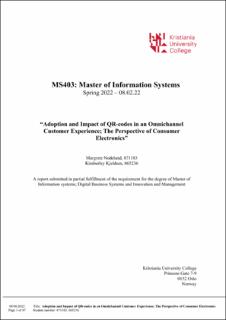| dc.description.abstract | Physical retailers are struggling to compete against digital players. Providing a positive
omnichannel customer experience instore has become a vigorous strategy to stay competitive
in today’s retail environment. QR-codes can offer a wide variety of digital information almost
instantaneously. Retailers of consumer electronics are suggested to benefit from this easy
access to information by responding to consumers need for interactive and personalized
experiences. QR-codes are especially suitable in the prepurchase stage of the customer
journey, in which consumers consider and evaluate products. Moreover, QR-codes has had a
revival due to its potential during the Covid-19 pandemic. Despite this, there is still an ongoing
discussion about the adoption of QR-codes and a lack of empirical insight on the impact of
QR-codes on the omnichannel customer experience as well as a lack of studies that take a
holistic approach to investigate QR-codes in a consumer electronics setting. The objective of
this study was therefore to fill this knowledge gap by answering the following research
questions: (1) why consumers adopt or resist QR-codes, and (2) which QR-code information
and features provides experiential value and influences purchase intention in consumer
electronics.
In answering the first question, a theoretical framework was developed, which extends the
Technology Acceptance Model with functional and physiological barriers from the Innovation
Resistance Theory, as well as potential moderating factors like age, gender, and personal
innovativeness. One or more hypotheses for each construct were based on extensive literature
review, and the framework was tested in a cross-sectional survey study. In answering the
second question, an experiential value and purchase intention framework was built upon
theories on customer experience. Based on literature regarding omnichannel behavior, QRcodes,
and shopper-facing technology, it was assumed that more digitalized and personalized
information and features were preferred by consumers. This assumption was tested using
conjoint analysis.
The findings from the cross-sectional survey shows that QR-code adoption is primarily driven
by perceived enjoyment, perceived usefulness, compatibility, and age. The findings from the
conjoint analysis generally indicate that less digitalized and personalized information and
features can add experiential value and that more digitalized and personalized trigger purchase
intention. Features such as personalized reviews should especially be consider by retailers as
this was important across both experiential value and purchase intention. In conclusion,
retailers should focus on both utilitarian and hedonic benefits of QR-codes and ensure that the
touchpoints fit with consumers’ shopping behavior and age. Retailers must also be aware that
there are differences in the preferences for what can create experiential value and purchase
intention, and they should carefully consider the purpose for which QR-codes are
implemented and allow this to guide them in what information and features they apply. | en_US |

